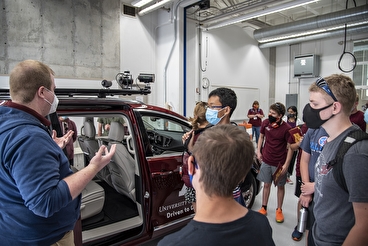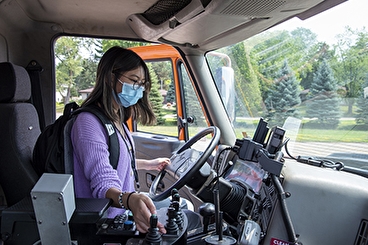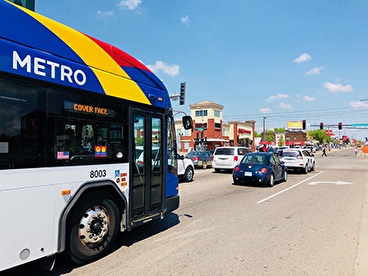State-of-the-art vehicle to drive CAV research, education

The University’s MnCAV Ecosystem launched operations with the arrival of its fully outfitted autonomous vehicle in July 2021. The collaborative program will facilitate research and testing of sensing technologies, vehicle control, platooning, traffic patterns, and other topics related to connected and autonomous vehicles (CAVs).
The centerpiece of the MnCAV Ecosystem’s research facilities is a 2021 Chrysler Pacifica Hybrid minivan that will serve as a customizable, experimental testbed. A suite of sensors allows the vehicle to “see” the world surrounding it, detecting objects and pedestrians and tracking their motion over time.
The MnCAV Ecosystem, established by CTS in 2020, will draw on its unique strengths to conduct research in the areas of cold weather conditions, equity, public perception and trust, the connected environment, and vulnerable road users. The program also offers educational activities to prepare the future workforce.
Program Director: Gina Baas, CTS. Sponsors: Thirteen partners, including a major contribution from the U’s Office of the Vice President for Research.
Learn more: State-of-the-art vehicle to drive CAV research, CTS Catalyst, August 2021
CAV Career Pathways Camp

The CAV Career Pathways Camp was held August 9–13 at the White Bear Lake Area High School. During the free camp, students explored CAV technology and discovered a variety of career opportunities in an industry that is helping to shape the future of transportation.
The students were among the first to see the U of M’s new MnCAV Ecosystem research vehicle, equipped for level 2 automation, as part of a campus tour.
Campers also rode an AV shuttle bus, took field trips to organizations working on CAV technology, and attended information sessions with practitioners and U of M researchers. A diverse mix of 18 high school students from the Twin Cities metro participated.
William Heise, a White Bear 11th grader, was impressed with the camp. “It really showed me a lot of different career paths that I can take.”
The camp was funded by the Federal Highway Administration and administered by MnDOT, with additional financial sponsorship from SICK Sensor Intelligence.
Learn more: CAV camp sparks career interests, possibilities for area students, CTS Catalyst, October 2021
National study aims to improve US transportation system with accessibility data

The Accessibility Observatory, a nationally recognized research unit within CTS, will be building on the success of its National Accessibility Evaluation and Access Across America work after securing support for an expanded second phase of the project.
With support from MnDOT, the Federal Highway Administration, and 14 other state DOTs, the second phase of the study, covering 2020–2024, will continue annual updates of national job access data and, critically, will expand the studied destination types to include education and health care.
In addition, the Observatory will provide study partners support with integrating accessibility data and concepts into transportation planning and performance management. By adding other destinations to the accessibility evaluation, the second phase will provide partners with an even more comprehensive look into regional transportation systems.
The new destinations are essential components of many people’s daily lives. Understanding how residents do or do not have easy access to these destinations can aid agencies in making decisions about how to adjust existing systems or target new investments in ways that open opportunities to a wider population.
Principal investigator: Andrew Owen, CTS/Accessibility Observatory. Sponsor: National Accessibility Evaluation, a multi-year pooled fund led by the Minnesota Department of Transportation.
Learn more: University of Minnesota national study aims to improve US transportation system with accessibility data, CTS Catalyst, February 2021
Model factors short trips into the spread of COVID-19

Modeling the spread of the COVID-19 pandemic is a critical part of controlling it. Previous models based on movement patterns mainly used long-distance travel to predict the spread of the virus, but new research is looking to include short-distance commutes as well.
U of M researchers are part of an initiative aiming to incorporate short-distance transportation data into viral spread models. They worked in tandem with contacts from Purdue University and the KTH Royal Institute of Technology on the effort.
Their model started with a basic SEIR model (Susceptible, Exposed, Infected, Recovered), which uses factors such as incubation time and duration of disease to predict the rate at which people transition from one of the SEIR categories to the next. Then, using a data aggregator, they gathered cellphone data on the number of trips people made from county to county in Minnesota.
By adding this travel data to the basic model, the researchers were able to create a new set of predictions for the spread of the virus and gain an understanding of how reducing travel affects viral spread. To check their work, they used county-to-county travel data for each week in 2020, as well as publicly reported infection data, and compared their model performance to the actual viral spread observed. The researchers then compared the resulting pattern with actual case numbers. They found that the model did a good job of capturing the virus spread—particularly because it incorporates the additional trips.
Investigators: Raphael Stern and Michael Levin, Department of Civil, Environmental, and Geo- Engineering. Sponsor: National Science Foundation.
Learn more: Factoring short trips into the spread of COVID-19, CTS Catalyst, February 2021